 Comcast’s plan to acquire Visible World, announced late Thursday, will deepen its addressable TV prowess, but the real target might be Visible World subsidiary AudienceXpress and its burgeoning buy-side dealings.
Comcast’s plan to acquire Visible World, announced late Thursday, will deepen its addressable TV prowess, but the real target might be Visible World subsidiary AudienceXpress and its burgeoning buy-side dealings.
Comcast’s inheritance of AudienceXpress, which provides provides digital workflow automation for the buying and selling of linear TV ads, could reduce the media giant’s reliance on third-party systems for monetizing unsold local inventory.
“Ultimately, that might be the biggest driver of this deal,” said Simulmedia founder and CEO Dave Morgan.
AudienceXpress has courted demand-side partners like Turn and TubeMogul over the past year, supplying access to inventory from 80 ad-insertable cable networks. If the acquisition goes through, Comcast could inch closer to the programmatic video demand side.
And 15-year-old Visible World brings value beyond AudienceXpress through its core offering as well. It was an early entrant into addressable TV advertising and claims access to 90% of domestic cable TV households.
Its platform helps many cable operators and multichannel video programming distributors from Cox Communications to Cablevision target ads via set-top boxes.
“As a company with technology that powers linear TV ad versioning, Visible World complements [Comcast’s] FreeWheel division, which powers digital video advertising for large companies,” said Morgan. “There is no question that all of the major TV players – from network groups to distribution platforms like Comcast – will gain competitive advantage over time by having their own complete TV/digital video ad technologies.”
Since acquiring video ad server FreeWheel in March 2014, Comcast has built a platform services group to manage advanced advertising initiatives for its own portfolio (NBCUniversal on the national side, Comcast SpotLight for local) as well as technologies for the greater ecosystem.
Comcast’s advanced ad development may be broken down into four parts: linear TV, linear-addressable TV (which provides data-enabled targeting at the household level), set-top box/video on demand and digital, which includes TV Everywhere apps, mobile and browser-based advertising.
Comcast is evaluating ways it can augment insights from set-top box data to power advertising in video on demand and, in turn, improve sequencing of messages across online video, mobile and TV Everywhere apps.
That strategy continues to be a point of contention for Comcast, which has ignited regulatory concerns whether its set-top box data creates an unfair advantage for its networks’ cross-platform sales efforts.
Programmers expressed similar complaints, claiming Comcast asks for digital content licensing rights alongside linear negotiations at equal or higher rates than other video distributors. Comcast’s $45 billion merger with Time Warner Cable crumbled in April, citing regulatory disapproval.
Visible World founder and CEO Seth Haberman noted in a blog post that Visible World would remain an independent entity, similar to Comcast’s acquisition of FreeWheel, upon the transaction’s closure.











